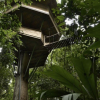
At Image Tree Service, Inc. in Windsor, CA, we know that without healthy roots a tree will not live a happy life. In this article, we study the different types of roots and how you can treat them right, as a homeowner or a property manager maintaining trees.
Surface Roots
Major tree roots often grow within a few inches of the soil surface. Some species, such as Maples, grow roots particularly close to the surface. Alternate freezing and thawing causes frost-heaving, which can expose roots that would otherwise remain below the soil surface. On slopes, soil erosion may also expose roots.
Keep them Safe and Growing
These surface roots could become a foot hazard or cause difficulty in mowing, and are easily injured. Removing these roots may disrupt the moisture supply to the tree, causing serious stress. Covering them with soil could cut off the oxygen supply to the fine roots in the soil below. Both situations could lead to decline.
Treat Your Tree with Mulch Love
The best solution is usually to mulch the area under the tree with compost and/or wood chips. These materials are porous enough to allow sufficient oxygen supply to the soil and may actually encourage fine root growth. Acting as an insulator, the mulch will minimize further frost-heaving and erosion. Another benefit is the replacement of highly competitive turf grass with mulch, which supplies nutrients as it decomposes. Grass removal is not necessary before the mulch is applied. If mulch is not an option, raise the soil surface by adding no more than two inches of half compost/ half-topsoil mix. An additional 2 inches can be added each year as necessary to raise the soil level sufficiently to cover the roots. The lawn can then be replanted, but the tree roots may reappear on the surface within a few years.
Girdling Roots
Tree roots that wrap around the base of the trunk can restrict the flow of water and nutrients up and down the trunk, leading to decline and dieback of the crown. Oaks are most susceptible to damage from girdling roots, but they can occur in most trees. When roots circling inside of a pot in the nursery cause the problem, the tree seldom survives more than a decade in the landscape. On “balled & burlapped” plants, girdling roots develop for different reasons and the decline may take 20 to 30 years to develop.
Keep It Stress-Free
To prevent girdling roots in nursery stock, make sure that all circling roots on the outside of the root ball are eliminated at time of planting. Research shows that moderate disruption of the container root system does not increase stress. For large girdling roots on established trees, correcting the problem can be difficult. Removal of the girdling roots may cause enough damage to the root system to hasten the decline. Several roots may be intertwined, making it even more difficult. It is difficult to predict if removing the roots will be more damaging than leaving them alone.
By making customer service paramount and focusing on performing quality work for each and every client, Image Tree Service, Inc. in Windsor, CA is a family- owned business that has been serving all of northern California for more than two decades. By building a solid reputation and priding ourselves on things like safety, accountability and transparency, Image Tree Service, Inc. we exhibit our passion for this industry with a work ethic that’s unmatched in this industry.
Categories: Tree Service, Tree Facts
















